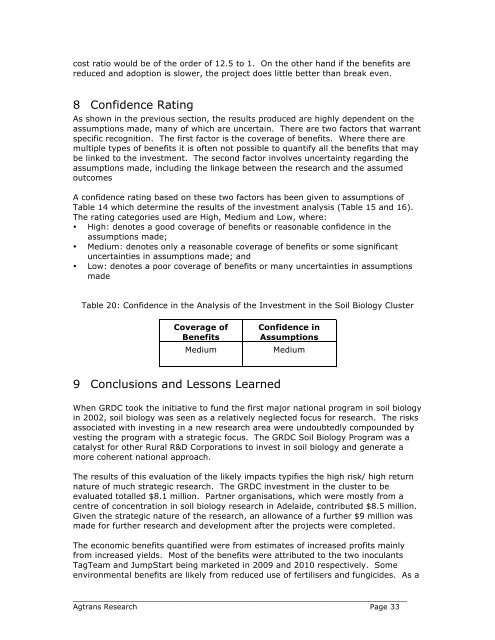impact assessment report series - Grains Research & Development ...
impact assessment report series - Grains Research & Development ...
impact assessment report series - Grains Research & Development ...
You also want an ePaper? Increase the reach of your titles
YUMPU automatically turns print PDFs into web optimized ePapers that Google loves.
cost ratio would be of the order of 12.5 to 1. On the other hand if the benefits are<br />
reduced and adoption is slower, the project does little better than break even.<br />
8 Confidence Rating<br />
As shown in the previous section, the results produced are highly dependent on the<br />
assumptions made, many of which are uncertain. There are two factors that warrant<br />
specific recognition. The first factor is the coverage of benefits. Where there are<br />
multiple types of benefits it is often not possible to quantify all the benefits that may<br />
be linked to the investment. The second factor involves uncertainty regarding the<br />
assumptions made, including the linkage between the research and the assumed<br />
outcomes<br />
A confidence rating based on these two factors has been given to assumptions of<br />
Table 14 which determine the results of the investment analysis (Table 15 and 16).<br />
The rating categories used are High, Medium and Low, where:<br />
• High: denotes a good coverage of benefits or reasonable confidence in the<br />
assumptions made;<br />
• Medium: denotes only a reasonable coverage of benefits or some significant<br />
uncertainties in assumptions made; and<br />
• Low: denotes a poor coverage of benefits or many uncertainties in assumptions<br />
made<br />
Table 20: Confidence in the Analysis of the Investment in the Soil Biology Cluster<br />
Coverage of<br />
Benefits<br />
Confidence in<br />
Assumptions<br />
Medium Medium<br />
9 Conclusions and Lessons Learned<br />
When GRDC took the initiative to fund the first major national program in soil biology<br />
in 2002, soil biology was seen as a relatively neglected focus for research. The risks<br />
associated with investing in a new research area were undoubtedly compounded by<br />
vesting the program with a strategic focus. The GRDC Soil Biology Program was a<br />
catalyst for other Rural R&D Corporations to invest in soil biology and generate a<br />
more coherent national approach.<br />
The results of this evaluation of the likely <strong>impact</strong>s typifies the high risk/ high return<br />
nature of much strategic research. The GRDC investment in the cluster to be<br />
evaluated totalled $8.1 million. Partner organisations, which were mostly from a<br />
centre of concentration in soil biology research in Adelaide, contributed $8.5 million.<br />
Given the strategic nature of the research, an allowance of a further $9 million was<br />
made for further research and development after the projects were completed.<br />
The economic benefits quantified were from estimates of increased profits mainly<br />
from increased yields. Most of the benefits were attributed to the two inoculants<br />
TagTeam and JumpStart being marketed in 2009 and 2010 respectively. Some<br />
environmental benefits are likely from reduced use of fertilisers and fungicides. As a<br />
_________________________________________________________________<br />
Agtrans <strong>Research</strong> Page 33

















